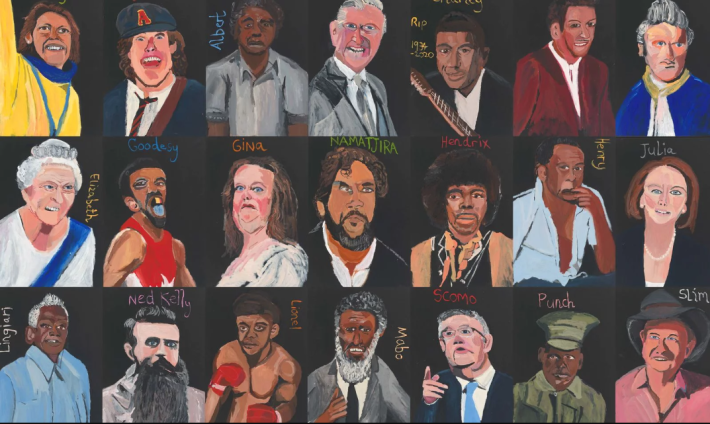I imagine that when you are one of the richest people alive, it is pretty uncommon that someone tells you "no." If you want caviar for breakfast, you eat caviar for breakfast. If you wish that caviar to be fresh from the Caspian Sea, the Learjet is already in the air. If you want to make sure that everyone is miserable but you, there are methods. There are few places left willing to stand up to these spoiled conscious babies that constitute our ruling class, but isn't it delicious when someone does?
Last week, billionaire mining tycoon Gina Rinehart pitched a little hissy fit, and someone stood up to her.
There is a painting up in the National Gallery of Australia in Canberra, and Gina does NOT like it! Granted, the painting is supremely unflattering. I would probably weep into a pile of money if I were a billionaire and someone made this painting of me, and then I would get a bunch of artists on the phone and commission 10 flattering paintings. That is not what Rinehart did. Like many rich people tend to do, she made her feelings everyone else's problem.
Rinehart demanded that the National Gallery of Australia remove the painting, and the National Gallery of Australia said no! Well, specifically, the National Gallery said, "Since 1973, when the National Gallery acquired Jackson Pollock’s Blue Poles, there has been a dynamic discussion on the artistic merits of works in the national collection, and/or on display at the gallery," and, “We present works of art to the Australian public to inspire people to explore, experience and learn about art.” Which is essentially "No ❤️."
Rinehart, who has apparently never heard of the Streisand effect, has also apparently never heard of bribes. She is listed as a "friend" of the National Gallery, which according to the National Gallery's website means she donated between $4,999 and $9,999. And that's in Australian dollars! For a billionaire, that is the equivalent of me donating one of my baby hairs.
The painting she's mad about was made by Indigenous Australian artist Vincent Namatjira and included in a survey of his work on display at the National Gallery. The painting of Rinehart is one of 21 canvas paintings hung together on a yellow wall that depict important figures in Australia's history. Rinehart's portrait is hung amongst other powerful people's like Queen Elizabeth II and outlaw Ned Kelly. Each painting is vivid and flat. The portraits are like demented boardwalk caricatures painted by someone who hates you, which is to say that I really like them.

Namatjira works from photographs. His colors are breezy, vibrant, but sparse. His depictions of the wealthiest people in the world emphasize how pale they are, how dull their eyes are, how wretched a person can appear when you know who they really are. They are almost cubist in their perspective.
This story about Rinehart's unhappiness over her depiction has been covered extensively. A lot of this coverage is tongue-in-cheek about how grotesque the portrait is. She is ruddy-cheeked and double-chinned and jowly, and her eyes droop. It is cartoonish in its exaggeration of her bad features, which is not to say it's a bad painting. Namatjira has practically put up a big blinking neon sign to make clear this isn't a skill issue on his part.
"I paint the world as I see it,” Namatjira told The Guardian. “People don’t have to like my paintings, but I hope they take the time to look and think, ‘Why has this Aboriginal bloke painted these powerful people? What is he trying to say?'"
But why paint Gina Rinehart in particular? The context makes it pretty clear. Gina is a nepo baby who inherited an Australian mining company. Her father, Lang Hancock, founded the company and also was openly racist toward Indigenous Australians. In a television interview in 1984, he explicitly stated that he wanted to round them up and sterilize them. Gina has refused to denounce her father's beliefs, so that's ... a choice! Two years ago, when netballer Donnell Wallam understandably asked to have the Hancock Prospecting logo removed from her jersey, Rinehart responded by pulling the entire $15 million sponsorship from Netball Australia.
Suddenly the portrait seems fair. Generous, even.
But Rinehart's portrait is just one of 21. Namatjira didn't intend that she alone is to be derided. His work places all of these portraits together for a reason. Look, it seems to say, how interconnected all of these people are, how some get to decide the world that the others live in. Who gets to be flattered, and who is supposed to do the flattering. Rinehart's tantrum is helping to show that great artwork's meaning doesn't end on the canvas.





